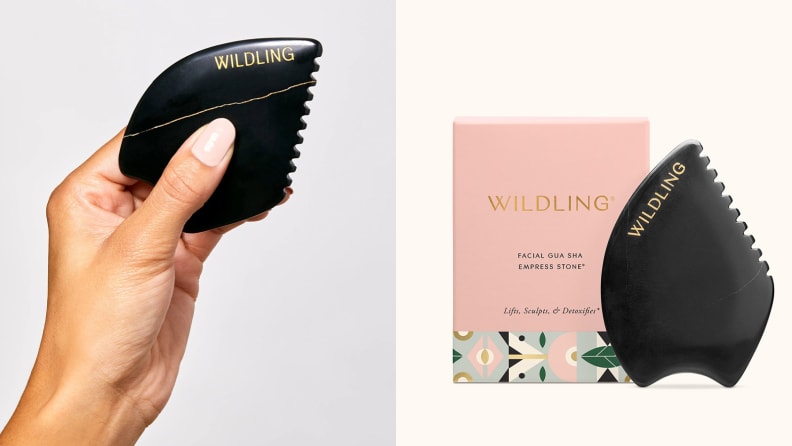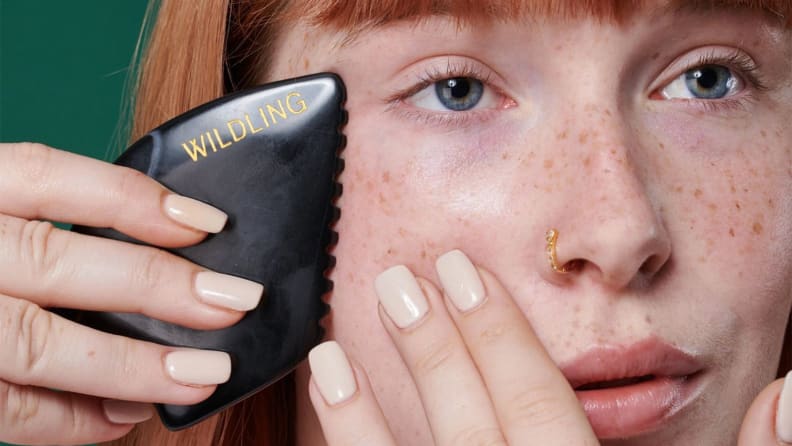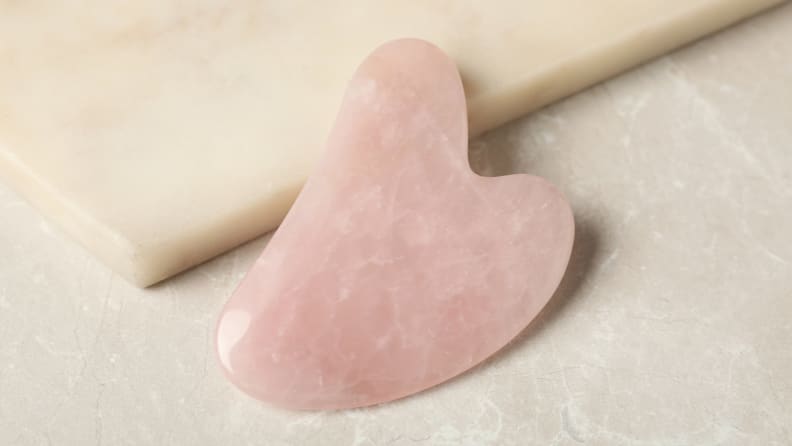What are the benefits of the skincare technique gua sha?
The ancient skin massage has risen in popularity recently.
Products are chosen independently by our editors. Purchases made through our links may earn us a commission.
Beauty rituals take many shapes and forms, especially because we all have different skin types and amounts of time we're willing to dedicate to them each day. If you don’t already have a short practice to reconnect to yourself, consider making your skincare routine a relaxing ritual. After all, washing your face and putting on moisturizer doesn’t have to feel like a chore. Your beauty routine is an opportunity to take 10 minutes to yourself to start or end your day with clarity, and there are plenty of tips and tools in the beauty world to make your routine extra special.
Recently, while watching a Youtube video, I discovered one of those special practices in the form of gua sha. I was mesmerized by the repetitive movements I saw on the screen and I felt like I could give it a try myself because the only prop is the gua sha stone itself. I also learned that the practice has been around for centuries. I’m a big believer in daily rituals, so trying gua sha for about 10 minutes each day sounded like a wonderful addition to my routine, and I think you may enjoy it, too.
What is gua sha?
Gua sha is an ancient beauty technique, but it’s been especially popular recently as self care, skincare routines and—let’s be honest—TikTok have grown in popularity. It’s similar to another skincare method called jade rolling, in which you roll a “jade” stone (more likely an amethyst or quartz) across the face using a tool that's similar in shape to a paint roller. “Gua sha” refers to a traditional Chinese method where someone glides a smooth, stone across the skin, especially on the face. Some stones are semi-flat and heart-shaped whereas others are triangular or abstract. Most stones have at least one smooth edge, a pointed area, and a “U” or “V-shape” cutout. The technique can be done by a professional or by you to your own skin at home.
You can adapt the gua sha routine to fit your skin’s needs. Because most gua sha stones have multiple edges, there are plenty of options for how to maneuver the stone across your skin. I like to use the U-shaped edge beginning at the center of my chin and then pulling it across my jawline toward my ear. After I do this eight to 10 times on one side, I switch hands and do the other side. You could also move the U-shaped part upward on your neck or cheekbone. The flat edge can be used in small, back-and-forth motions to reduce wrinkles while the curved edge is nice for long downward strokes. Each edge can also perform lifting movements, which is said to sculpt cheek and brow bones and boost skin elasticity.
What does gua sha claim to do?
Gua sha touts several skin-enhancing benefits. It claims to aid in lymphatic drainage (the flushing of toxins through tiny vessels under the skin), which releases muscle tension and reduces puffiness. Gua sha fans also claim that swiping the tool in alternate directions across the skin can help sculpt, lift, and reduce wrinkles in the skin. There's an emphasis on using the stone on the face, but Gua sha can actually be done all over your body to relieve tension. Once you're comfortable using the stone, you can try using it on your scalp, arms, and chest. The benefits of gua sha, both immediate and long-lasting, have yet to be scientifically substantiated or proven but centuries of anecdotal use through the ages—plus the relaxing benefits—may be enough enticement to give it a try.
What does the Empress Stone claim?

The Empress Stone from Wildling has a "U-shaped" edge, a curved side, a comb-like side, and a pointed tip.
To see what gua sha feels like on the skin—and to test its claims—I tried Wildling Beauty’s Empress Stone. This particular tool is made from Bian stone, which is “an amalgamate of 40+ minerals known for their healing properties.” The stone has four edges and a pointed tip, each of which is designed to be used on a different area of the skin or for certain methods, such as smoothing, plumping, massaging, sculpting, and draining.
When I received the stone in the mail, I was impressed—and thankful—that it was protected by several layers of packaging. The stone has a bit of weight to it and I’d consider it fragile. If you were to drop it a few feet onto your countertop or floor, it’d likely break.
The Empress Stone claims to erase fine lines and wrinkles, plump skin, brighten complexion, minimize pores, reduce lymphatic congestion, clear skin, and lift and sculpt the skin. I was surprised—and skeptical—that a single stone might do so much, so I dove into the practice to see if it delivered on reducing puffiness and relieving tension, the claims I could potentially see for myself.
How do you prepare for gua sha?
Gua sha requires a bit of preparation. I didn’t want to irritate my skin, so I read the Wildling Beauty blog (I figured I'd use Wildling as my source, as I purchased its product) and saw that it recommended using facial oil to help the stone glide across skin instead of tugging at it. Each time I used the stone, I applied one of the oils that I had on hand, like the Biossance 100% Squalane Oil. I also washed the stone with warm water and my Youth To The People Superfood Cleanser then gently dried it with a hand towel prior to each use. I did so to clear off dust and oil from the previous use, but you could probably skip the cleansing step if you’d washed your stone after each use and stored in a clean place, like a soft makeup bag or pouch.
I also watched a few videos, as I wasn’t sure where to start—literally. I didn't know where on my face to place the stone. Some videos recommended beginning at the base of the skull and moving the stone down the neck. Other videos suggested starting at the jaw to reduce tension. I found this explainer video from Wildling Beauty helpful, as well as this real-time guided practice.
What's it like to use a gua sha stone?

The comb-like edge of Wildling's Empress Stone feels great on the forehead.
The first time I used the Empress Stone, I tried different amounts of pressure, which led to red skin where I pressed too hard but less puffiness. It also took me a few tries to figure out how to hold the stone in my hand so that it felt natural and the edges lined up with where I wanted them to land against my skin. For example, I wanted to use the “U-shape” on my jawline and then swipe downward when I reached the end of my jaw near my earlobe. At first, I tried holding the stone with the comb-like side up but realized holding that side down made it easier to perform the downward motion with the long side. Now, after using the stone daily for a few weeks, I feel like I have the hang of it. I don’t apply much pressure while I move the stone across my skin, but I tend to push slightly harder on tougher areas of skin like the back of my jaw and the back of my neck.
Generally, I work up one side of my face and then do the other, but you could also work more symmetrically. I like to start by placing the “U-shape” part of the stone over my jawline, with the “U” curve framing my jaw and into my face and the pointy end sitting in the palm of my hand. From there, I sweep the stone up the curve of my jawline toward my ear. Once I reach my ear, I keep the stone as it is but shift the pressure to the top edge and move downwards from my jaw to my neck. I find this helps reduce tension from grinding my teeth at night.
Then, keeping the stone’s orientation the exact same as it was on my jawline, I move it up so that the “U” curve is straddling my cheekbone and again sweep out and up. My favorite motion is softly moving the long, curved edge over my brow bone, starting in the center of my face and moving toward my ears; it’s so calming and grounding. I do each “set” of movements eight to 10 times and then use the long, curved side to “drain” my skin by scraping downward. To be clear, you won’t feel any “draining,” but many videos recommend finishing with this motion for lymphatic drainage that helps de-puff, so I’ve incorporated it into my routine to see what I notice.
I used the stone in the mornings some days and at night on others. I don’t prefer one over the other, but I liked to switch it up. In the morning, it was nice to gua sha before washing my face so I could rinse the oil off, and I felt a boost in confidence having started my day out with this ritual. Gua sha feels relaxing, so doing it at night helps me wind down from the day and sneak in a bit of quiet time while I move across the areas on my face.
Does gua sha do what it claims?
I can see a difference in my skin after a few minutes of using the Empress Stone, and my roommate and boyfriend agreed, so it’s not just my wishful thinking! My cheeks looked less puffy, my jawline was a bit sharper, and my eyes looked more awake. I have ultra-sensitive skin that tends to welt easily when touched, so when I finish my gua sha routine, I tend to have some redness and bumps, but they fade after 10 minutes or so.
I noticed a reduction in jaw and forehead tension as a result of my gua sha routine, too. I also feel like my cheekbones stand out more now than they used to, and as someone with big cheeks, that says a lot. My complexion seemed brighter, my pores look smaller, and my skin feels firmer.
It could be that all of these effects are simply because I'm taking more diligent care of my skin than I was before, or a placebo effect because I'm looking for them. While these measures are subjective, the stone helped me connect with myself each day and left me feeling more confident and bright, which is a win in my book.
Is the Empress Stone worth it?

Experts recommend you start with your neck before you use the gua sha technique on your face.
There isn’t anything about the Empress Stone I don’t like, and I’m definitely going to keep using it. I want to learn more uses, movements, and ways to sculpt my skin. I also want to get better at using my non-dominant hand to get even results on both sides of my face. If you like beauty rituals, especially those that feel like a spa treatment at home, I think you’d love gua sha. The Empress Stone sells for $65, which is comparable to specialized beauty tools like jade rollers and facial cleansing brushes. Still, you can find more affordable tools from places like Sephora and Amazon, if you want to try the trend but aren’t ready to commit.
Who should try gua sha?

Gua sha may be a relaxing ritual.
Anyone can try gua sha, but you’re more likely to see results with consistent use. Even then, a gua sha tool isn’t proven effective for everything it claims and evidence it works is merely anecdotal. However, you may enjoy the tool for how it feels, even if you don’t see all of the results it claims to deliver.


